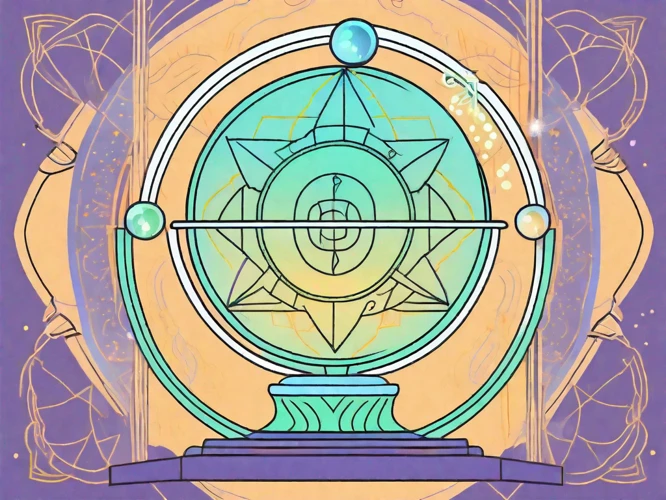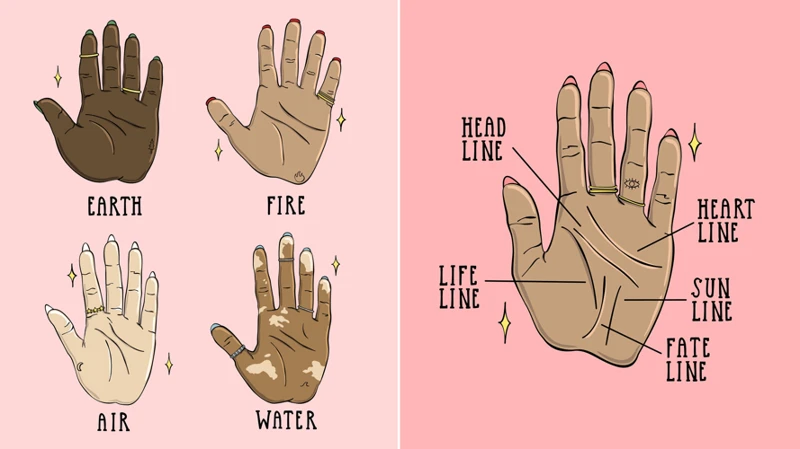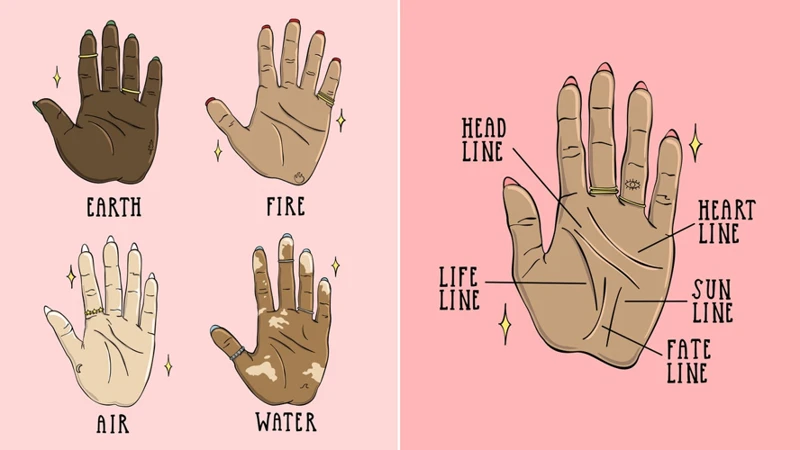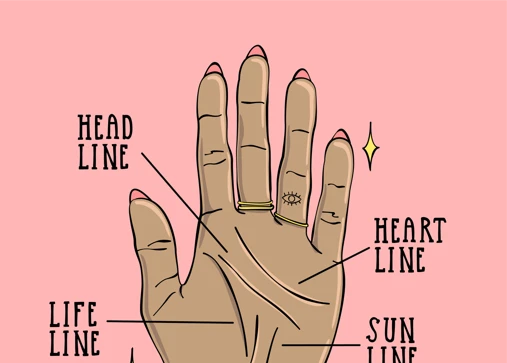When it comes to uncovering the secrets of the future, there are few tools as ancient and mysterious as palmistry. Throughout the ages, individuals have turned to the lines and contours of their hands in a quest for insight into their destinies. But where did this practice originate? How has it evolved over time? In this article, we will delve into the captivating history and origins of palmistry, exploring its ancient roots, its thriving existence in the Middle Ages and the Renaissance, and its relevance in the modern world. Get ready to embark on a journey through time as we unlock the hidden knowledge concealed within the palms of our hands.
Contents
- The Origins of Palm Reading
- The Influence of Ancient Cultures
- Palmistry in the Middle Ages
- The Renaissance and Beyond
- Scientific Perspectives on Palmistry
- Common Palmistry Traditions and Techniques
- The Popularity of Palmistry Today
- Conclusion
-
Frequently Asked Questions
- 1. Can palmistry predict the future?
- 2. Is palmistry a science or a pseudoscience?
- 3. How accurate is palmistry?
- 4. Can palmistry determine a person’s personality?
- 5. Is palmistry a culturally universal practice?
- 6. Can palmistry be learned and studied?
- 7. Can palmistry reveal information about relationships?
- 8. Does palmistry have any religious significance?
- 9. Can palmistry be used for medical purposes?
- 10. Can palmistry change a person’s life?
- References
The Origins of Palm Reading

The Origins of Palm Reading date back thousands of years, with evidence of its practice found in ancient civilizations all over the world. While the exact origins remain unclear, palmistry is believed to have been first developed in ancient India, China, and Egypt. In India, palmistry, known as Hasta Samudrika Shastra, was mentioned in the ancient Hindu scriptures, the Vedas, which are believed to be over 5,000 years old. It was considered a sacred art and was closely intertwined with astrology and spirituality. Similarly, in ancient China, palmistry was highly regarded and was often used as a tool for fortune-telling and medical diagnosis. Greek and Roman cultures also contributed to the development of palmistry, with Greek philosopher Aristotle studying the lines on hands and correlating them to various personality traits. The practice became especially popular during the Roman era, with palmists being consulted by emperors and aristocrats for guidance. The ancient cultures laid the foundation for palmistry, and their belief in the interconnectedness of the mind, body, and soul shaped the way palm reading is interpreted today. To learn more about the different interpretations of palm shapes, visit our article on the meaning of palm shapes in palmistry.
The Influence of Ancient Cultures

Ancient cultures played a vital role in shaping the practice of palmistry, each adding their own unique perspectives and interpretations. In ancient China, palmistry was deeply rooted in Taoist and Confucian philosophies, with the belief that the hands held a map of an individual’s destiny. Chinese palmists analyzed the shape, size, and textures of the hands, focusing on specific features such as the length of the fingers, the prominence of the knuckles, and the patterns of the skin. Indian palmistry, known as Hasta Samudrika Shastra, combined palm reading with astrology and yogic principles. Practitioners believed that the lines on one’s palm were influenced by the movement of celestial bodies and could reveal insights into a person’s character, health, and future. Greek and Roman cultures also held palmistry in high regard, with Greek philosopher Aristotle delving into the study of palm lines and associating them with personality traits. The Romans developed a system of palmistry known as chiromancy, which gained popularity throughout the empire. Palmistry in these ancient cultures reflected their beliefs in the interconnectedness of the spiritual and physical realms. For a closer look at the intricacies of line interpretation in palmistry, be sure to check out our article on palm line interpretation. To understand the scientific perspectives on palmistry, visit our article on the science behind palm reading.
1. Ancient Chinese Palmistry
Ancient Chinese Palmistry holds a significant place in the history of palm reading. Dating back over 3,000 years, it was deeply rooted in the belief that the lines and characteristics on a person’s hand held valuable information about their destiny. Chinese palmistry, known as “Cheirosophy” or “Palmistry of the Nine Palaces,” was influenced by the principles of Yin and Yang, Five Elements Theory, and the I Ching, or Book of Changes. These philosophies were believed to shape a person’s life and their individual attributes.
In Chinese palmistry, the hand is considered a microcosm of the universe, with the palm representing the earth and the fingers symbolizing the celestial bodies. The practice focused on three main aspects: the shape of the hand, the lines on the palm, and the mounts or bumps on the hand. Each of these elements provided insight into different aspects of a person’s life, such as their character, health, relationships, and career prospects.
The shape of the hand was thought to reveal one’s innate personality traits. For example, a square hand was associated with practicality and stability, while a long and slender hand indicated a more artistic and sensitive nature. The lines on the palm, such as the heart line, head line, and life line, were carefully examined for their length, depth, and curvature. These lines were believed to disclose information about love, intelligence, and longevity, respectively.
The mounts on the hand, which are fleshy areas corresponding to different planets, were also significant in Chinese palmistry. For instance, a prominent Jupiter mount was seen as a sign of ambition and leadership skills, while a well-developed Venus mount indicated a passionate and affectionate nature.
In addition to analyzing the hand’s physical features, ancient Chinese palmists considered the overall energy balance within the body. They believed that imbalances in Yin and Yang or the Five Elements could lead to health issues or obstacles in life.
Ancient Chinese Palmistry was deeply ingrained in Chinese culture and was used for various purposes, from predicting one’s future to determining compatibility in marriage. While the practice has evolved over time, its rich history and wisdom are still revered and followed by many enthusiasts and practitioners around the world today. To delve deeper into the art of palmistry and understand the interpretations of the lines on the palm, check out our article on palm line interpretation.
2. Indian Palmistry (Hasta Samudrika Shastra)
Indian Palmistry, also known as Hasta Samudrika Shastra, is a fascinating branch of palmistry that originated in ancient India. Dating back thousands of years, this practice was highly regarded and considered a sacred art form. Hasta Samudrika Shastra translates to “the ocean of hand features” and is based on the belief that the human hand is a microcosm of the universe, containing valuable information about one’s life, personality, and destiny.
In Indian Palmistry, the hand is examined in great detail, focusing on various elements such as the shape of the hand, the fingers, the mounts, and the lines. Each of these components is believed to hold significant meaning and can be analyzed to gain insights into a person’s character and future. For example:
– Hand Shape: The shape of the hand is divided into several categories, such as square, rectangular, conical, and spatulate. Each shape is said to indicate different personality traits and aptitudes.
– Fingers: The length, shape, and flexibility of the fingers are examined. It is believed that each finger represents a different aspect of life, such as intellect, emotions, communication, and creativity. By analyzing the fingers, palmists can gain insight into a person’s strengths and weaknesses in these areas.
– Mounts: The mounts are the fleshy areas on the palm, such as the mounts of Jupiter, Saturn, Apollo, and Venus. Each mount is associated with specific characteristics and can provide information about a person’s talents, ambitions, and temperament.
– Lines: The lines on the hand, such as the life line, heart line, and fate line, are meticulously studied. Their length, depth, and intersections are examined to reveal details about one’s health, relationships, career, and overall fortune.
Indian Palmistry is deeply rooted in Hindu astrology and spirituality. It is believed that the lines and features on the hand are influenced by cosmic energy and can guide individuals on their life journey. Palmists who practice Hasta Samudrika Shastra devote years to studying and mastering the intricate art of palm reading, honing their intuition and interpretation skills.
Today, Indian Palmistry continues to be widely practiced and revered in India and around the world. People turn to palmists trained in the Hasta Samudrika Shastra to gain insight into their personal and professional lives, seek guidance for decision-making, and understand their strengths and weaknesses more deeply. The ancient wisdom of Indian Palmistry serves as a reminder of the profound connection between the individual and the universe, offering a unique perspective into the mysteries of the human hand.
3. Greek and Roman Palmistry
Greek and Roman Palmistry played a significant role in the development and refinement of palm reading practices. During this era, palmistry flourished as a respected and influential art form. Greek philosopher Aristotle, known for his keen observations and scientific approach, delved into the study of palm lines. He believed that the lines on the palm held clues to a person’s character and potential. Aristotle’s work laid the groundwork for future palmists, who further expanded on his theories.
In ancient Rome, palmistry became even more popular. The Romans believed that the gods bestowed unique traits and destinies upon each individual, and these characteristics were reflected in the lines on their hands. Roman palmists were consulted by nobility and prominent figures to gain insight into personal traits, future events, and even political matters. Emperor Augustus, in particular, was known to consult palmists regularly.
During this period, palmistry began to incorporate the interpretation of individual palm lines. Each line represented different aspects of a person’s life, such as their love life, wealth, and career. For example, the heart line, which indicates emotions and relationships, was closely examined to provide insight into matters of the heart.
Greek and Roman palmistry contributed to the development of hand analysis as a comprehensive system. The practice continued to evolve, incorporating new techniques and interpretations over time. To delve deeper into the fascinating world of line interpretation in palmistry, you can explore our article on palm line interpretation.
Palmistry in the Middle Ages

Palmistry in the Middle Ages was a period marked by both fascination and uncertainty surrounding the practice. While palmistry continued to be practiced, it also faced opposition and skepticism from the Church. The Church viewed the practice as a form of divination and therefore condemned it as a pagan and occult activity. However, despite the Church’s disapproval, palmistry persisted and thrived among the common people who sought guidance and solace in the uncertain times. Palm readings were often conducted in secret or under the guise of other activities to avoid potential persecution. During this time, palmists would focus on specific features of the hand, such as the length and shape of the fingers or the prominence of certain mounts, to reveal aspects of a person’s character or predict their future. Palmistry in the Middle Ages was intertwined with other forms of divination, such as astrology and numerology, as practitioners believed in the interplay of celestial forces and their influence on the hand. Despite the challenges it faced, palmistry continued to evolve and adapt, paving the way for its resurgence in the Renaissance era.
The Renaissance and Beyond

During the Renaissance and beyond, palmistry continued to flourish and evolve. This period saw a resurgence of interest in the occult and esoteric sciences, leading to a renewed fascination with palm reading. In the 16th century, palmistry gained popularity among European nobility and intellectuals. Books and manuscripts on the subject were written, providing detailed instructions on how to read palms and interpret various signs and symbols. One influential figure during this time was the French physician and astrologer, Ambroise Paré, who studied the connection between palmistry and medical conditions. However, as the scientific revolution took hold, palmistry faced criticism and skepticism. It was dismissed as pseudoscience and fell out of favor for a time. Nevertheless, palmistry endured, adapting to the changing times. In the 20th century, new approaches to palmistry emerged, blending traditional techniques with psychological analysis and character assessment. Today, palmistry continues to captivate individuals around the world who seek self-discovery and guidance in the intricate patterns etched on their hands.
1. The Rise of Scientific Palmistry
During the Renaissance, palmistry experienced a shift towards a more scientific approach. Scholars and philosophers began to use empirical methods to study the lines and markings on the palm. Ambroise Paré, a French surgeon, was one of the pioneers of this scientific approach to palmistry. He believed that the lines on the palm were indicative of different aspects of a person’s character. Paré’s work paved the way for other scientists and physicians to delve deeper into the study of palmistry. Lorenz Ramsauer, an Austrian physician, further developed the scientific aspects of palmistry in the 19th century. He conducted extensive research on the relationship between hand shape, lines, and various medical conditions. Ramsauer’s findings emphasized the connection between the physical body and the lines on the palm. This scientific approach to palmistry gained popularity and credibility among intellectuals and researchers of the time. Palmistry was now seen as a tool for understanding human psychology and the interconnectedness of the mind and body. The rise of scientific palmistry marked a significant turning point in the history of this ancient practice. To learn more about the scientific perspectives on palmistry, check out our article on the science behind palm reading.
2. Modern Palmistry Practices
Modern palmistry practices have evolved significantly over the centuries, incorporating a combination of ancient wisdom and contemporary understanding. Today, palmistry is often seen as a tool for self-discovery and personal development. Here are some key aspects of modern palmistry practices:
1. Hand Analysis: Modern palmists analyze various aspects of the hand, including the shape, size, and texture of the palm, fingers, and nails. Each of these elements is believed to provide insight into different personality traits and potential life paths. For example, a person with a square palm may be seen as practical and grounded, while one with long fingers might be considered creative and intuitive.
2. Line Interpretation: The lines on the palm, such as the heart line, head line, and life line, are carefully examined and interpreted in modern palmistry. These lines are believed to represent different aspects of one’s life, including emotions, intellect, and physical well-being. Palmists analyze the length, depth, and curves of these lines to gain further insights into an individual’s personality and future prospects. Visit our article on palm line interpretation to explore the meanings behind each line.
3. Mount Examination: The mounts, which are the fleshy areas on the palm, are also an important focus in modern palmistry. Each mount is associated with specific qualities and influences. For example, the mount of Venus is linked to love and passion, while the mount of Mercury is connected to communication and intelligence. By examining the size, shape, and firmness of these mounts, palmists can provide guidance on various aspects of life, such as relationships, career prospects, and health.
4. Integration with Other Practices: Modern palmistry often integrates with other disciplines, such as astrology and psychology. Palmists may consider astrological factors, such as the positions of the planets and zodiac signs, to provide a more comprehensive analysis. Additionally, they may incorporate psychological insights to help individuals better understand their behavioral patterns and personal relationships.
It’s important to note that modern palmistry is not seen as a definitive prediction of the future but rather as a tool for self-awareness and guidance. Ultimately, the individual has the power to shape their own destiny.
Scientific Perspectives on Palmistry

Scientific Perspectives on Palmistry have been mixed throughout history. While many skeptics dismiss palmistry as a pseudoscience, there have been scientific studies and theories that explore the potential correlations between hand features and personality traits, health conditions, and genetic factors. One area of scientific interest is dermatoglyphics, which examines the patterns of ridges and grooves on the fingertips and palm. Research has shown that these patterns are unique to individuals and can provide information about genetic disorders and certain medical conditions. Another scientific approach to palmistry revolves around the study of finger lengths and their connection to hormone exposure during fetal development. One theory suggests that the ratio of the index finger to the ring finger, known as the digit ratio, may indicate prenatal hormone levels and has been linked to various personality traits and even the likelihood of certain diseases. However, it is important to note that scientific perspectives on palmistry remain mostly speculative and have not been universally accepted in the scientific community. While palmistry continues to intrigue and captivate individuals, its scientific validation and rigorous study are still ongoing. To explore the scientific aspects of palmistry further, read our article on the science behind palm reading.
Common Palmistry Traditions and Techniques

Common Palmistry Traditions and Techniques encompass a wide variety of methods used to interpret the lines, shapes, and mounts on the palm. One of the fundamental techniques in palmistry is palm shape analysis, which involves examining the overall shape of the hand, such as whether it is square, rectangular, or conical. Each shape is believed to indicate different personality traits and characteristics. Another important aspect is line interpretation, where the lines on the palm, such as the life line, head line, and heart line, are studied for insights into different aspects of a person’s life, including health, intellect, and emotions. Additionally, palmists often conduct mount examination, which involves analyzing the various mounts on the palm to understand a person’s strengths, weaknesses, and potential talents. By combining these techniques, palm readers can provide a comprehensive analysis of an individual’s personality, destiny, and potential future. If you’re curious to learn more about the different techniques used in line interpretation, be sure to check out our detailed guide on palm line interpretation.
1. Palm Shape Analysis
Palm shape analysis is a fundamental aspect of palmistry, as it provides valuable insights into an individual’s character and temperament. There are several different palm shapes that palmists analyze to gain a deeper understanding of a person’s personality traits.
1. The Earth Hand: A person with an Earth hand typically has a square or rectangular palm with well-defined lines and fingers. This palm shape is associated with practicality, reliability, and a strong work ethic. People with Earth hands are often grounded, goal-oriented, and dependable.
2. The Air Hand: An Air hand is characterized by a square or rectangular palm with long fingers. Individuals with this palm shape are often intellectually driven, sociable, and communicative. They possess excellent problem-solving skills and are adept at expressing their thoughts and ideas.
3. The Water Hand: People with Water hands have oval-shaped palms and long, flexible fingers. They are known for their emotional sensitivity, creativity, and intuition. Individuals with Water hands are often in touch with their emotions and have a keen sense of empathy.
4. The Fire Hand: A Fire hand is recognizable by its triangular or conical palm shape and short fingers. Those with Fire hands are passionate, energetic, and ambitious. They have a natural zest for life and are often described as confident, adventurous, and charismatic.
5. The Mixed Hand: Some individuals have a combination of different palm shapes, with various elements representing different traits. Palmists carefully analyze the dominant shape and the influence of the other elements to create a comprehensive understanding of the person’s character.
Analyzing the palm shape is just the first step in palmistry. It sets the foundation for further examination of lines, mounts, and other features on the hand. To delve deeper into the intricacies of palmistry, explore our article on palm line interpretation.
2. Line Interpretation
Line interpretation is a crucial aspect of palmistry that involves examining the various lines on the palm to gain insight into an individual’s personality, potential, and future. There are several key lines that palm readers focus on during line interpretation:
1. The Life Line: The life line is perhaps the most well-known line in palmistry. It starts above the base of the thumb and curves downward towards the wrist. Contrary to popular belief, it does not predict the length of one’s life but rather provides information about their physical health, vitality, and major life events.
2. The Head Line: The head line, also known as the wisdom line, runs horizontally across the palm. It represents an individual’s intellectual capacity, communication skills, and problem-solving abilities. A long, straight head line may indicate a logical and analytical mind, while a curved line suggests creativity and intuition.
3. The Heart Line: The heart line is located above the head line and represents a person’s emotions, relationships, and romantic inclinations. It can provide insights into one’s emotional well-being, empathy, and approach to love. A deep and clear heart line indicates a passionate and emotionally fulfilled individual, while a broken or faint line may suggest emotional challenges.
4. The Fate Line: Also known as the career line, the fate line reveals a person’s professional path and achievements. It runs vertically through the center of the palm and can provide insights into one’s career choices, success, and obstacles. A strong and unbroken fate line may indicate a defined career path, while a faint or fragmented line could suggest a more unpredictable professional journey.
Other lines, such as the fame line, marriage line, and money line, can also be analyzed during line interpretation to provide additional information about specific aspects of a person’s life. It’s important to note that no single line defines a person’s destiny, and a comprehensive analysis of palmistry considers the interplay between multiple lines and features on the palm. To learn more about the intricate details of line interpretation in palmistry, explore our informative article on palm line interpretation.
3. Mount Examination
Mount examination is a crucial aspect of palmistry that involves analyzing the various mounts present on the palm. These mounts are the fleshy areas that lie beneath the fingers and represent different aspects of a person’s life and personality. Each mount is associated with a specific planet and is believed to influence certain characteristics and traits. The examination of these mounts helps palmists gain a deeper understanding of an individual’s strengths, weaknesses, and potential challenges they may face. Here are some of the key mounts and their corresponding interpretations:
1. Mount of Jupiter: Located below the index finger, the Mount of Jupiter signifies leadership qualities, ambition, and a strong desire for success. A well-developed and prominent mount is an indication of a person’s leadership potential and their ability to make wise decisions.
2. Mount of Saturn: Situated beneath the middle finger, the Mount of Saturn represents discipline, responsibility, and a serious demeanor. A high and firm mount suggests a practical and organized individual, while a low mount may indicate a more laid-back and carefree nature.
3. Mount of Apollo: Found beneath the ring finger, the Mount of Apollo symbolizes creativity, self-expression, and a love for the arts. A well-defined and elevated mount is often seen in individuals who possess artistic talent, while a flat or underdeveloped mount may suggest a lack of creative inclination.
4. Mount of Mercury: Located below the pinky finger, the Mount of Mercury is associated with communication, intelligence, and adaptability. An ample and protruding mount signifies excellent communication skills and a sharp intellect, while a small and flat mount may indicate difficulty in expressing oneself effectively.
5. Mount of Venus: Situated at the base of the thumb, the Mount of Venus represents love, sensuality, and emotional well-being. A well-developed mount is a sign of a passionate and affectionate individual who enjoys and seeks out emotional connections, while a shallow or underdeveloped mount may suggest a more reserved or detached nature.
By examining and interpreting the mounts on a person’s hand, palmists gain valuable insights into their personality traits, talents, and potential life paths. Remember, palmistry involves a holistic analysis of various elements, such as palm shape, line interpretation, and mount examination. To learn more about the different aspects of palmistry, visit our article on palm line interpretation.
The Popularity of Palmistry Today
The Popularity of Palmistry Today has experienced a resurgence in recent years. Despite being an ancient practice, it continues to captivate people’s curiosity and intrigue. In today’s fast-paced and uncertain world, many individuals seek guidance and insight into their lives, and palmistry offers a unique perspective. Modern technology has also played a role in the popularity of palmistry, with online palm reading services and apps gaining traction. People can now access palmistry readings from the comfort of their own homes and at their convenience. Additionally, palmistry has found its place in popular culture, with references in movies, television shows, and books. Celebrities have also embraced palmistry, further fueling its popularity. However, it is essential to note that while palmistry has its enthusiasts, it also faces skepticism and criticism. Skeptics argue that palmistry lacks scientific evidence and is merely based on subjective interpretations. Despite the skepticism, palmistry continues to thrive and is valued by those who seek guidance and self-discovery.
Conclusion
In conclusion, palmistry has a rich and diverse history that spans across cultures and centuries. From its ancient origins in India, China, and Egypt to its prominence in Greek, Roman, and medieval European societies, palmistry has consistently fascinated and intrigued people seeking insight into their lives. Over time, the practice has evolved and adapted, incorporating scientific perspectives and modern techniques while still preserving its mystical allure. Today, palmistry remains popular, with practitioners using various traditions and techniques to analyze palm shape, interpret lines, and examine mounts. While opinions on the validity and accuracy of palmistry may differ, its enduring popularity is a testament to its appeal and the human desire to unlock the secrets of the future. Whether one embraces palmistry as a guiding tool or approaches it with skepticism, there is no denying its cultural significance and the countless individuals who continue to find fascination and meaning in the intricacies of palm reading.
Frequently Asked Questions
1. Can palmistry predict the future?
Palmistry is not a definitive method for predicting the future. It provides insights into a person’s character traits, potential strengths and weaknesses, and can suggest possible life paths. However, it is ultimately up to the individual to shape their own destiny.
2. Is palmistry a science or a pseudoscience?
Palmistry is often considered a pseudoscience, as it lacks empirical evidence and scientific validation. While some aspects of palmistry may have psychological and cultural significance, it is not recognized as a scientific discipline.
3. How accurate is palmistry?
The accuracy of palmistry varies from practitioner to practitioner. Interpretation of palm lines and shapes is subjective, and it heavily relies on the skill, intuition, and experience of the palmist. It is important to approach palmistry with an open mind and view it as a tool for self-reflection rather than absolute truth.
4. Can palmistry determine a person’s personality?
Palmistry can provide insights into a person’s personality traits. For example, the size and shape of the hand, the length and quality of the fingers, and the prominence of certain features like mounts can give indications about a person’s character, temperament, and potential talents.
5. Is palmistry a culturally universal practice?
Palmistry has been practiced in various cultures throughout history. While some cultural interpretations differ, the fundamental belief in the significance of hands and their connection to human life is universal.
6. Can palmistry be learned and studied?
Yes, palmistry can be learned and studied. There are numerous books, courses, and resources available that teach the basics of palmistry, including the interpretation of lines, mounts, and shapes. However, mastery of palmistry requires practice and experience.
7. Can palmistry reveal information about relationships?
Yes, palmistry can provide insights into a person’s relationships. By examining the lines and mounts on the hand, a palmist may offer guidance on compatibility, communication styles, and potential challenges in relationships.
8. Does palmistry have any religious significance?
Palmistry has religious significance in certain cultures and belief systems. For example, in Hinduism, palmistry is closely tied to astrology, and the lines on the hand are believed to be influenced by planetary positions at the time of a person’s birth.
9. Can palmistry be used for medical purposes?
Palmistry is not recognized as a medical diagnostic tool in modern medical practice. However, in ancient times, some cultures believed that the lines and features on the hand could provide clues about a person’s health and potential ailments.
10. Can palmistry change a person’s life?
Palmistry itself does not change a person’s life. However, the insights gained through palmistry can lead to self-reflection and personal growth. By understanding their strengths and weaknesses, individuals may make conscious choices that can positively impact their lives.







